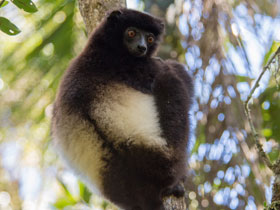Milne-Edwards's sifaka or Milne-Edwards's simpona (Propithecus edwardsi)
Milne-Edwards's sifaka (Propithecus edwardsi), or Milne-Edwards's simpona, is a large arboreal, diurnal lemur endemic to the eastern coastal rainforest of Madagascar. Milne-Edwards's sifaka is characterised by a black body with a light-coloured "saddle" on the lower part of its back. It is closely related to the diademed sifaka, and was until recently considered a subspecies of it. Like all sifakas, it is a primate in the family Indriidae.
Appearance
Propithecus edwardsi is a large lemur, endemic to the eastern coastal forests of Madagascar. It is distinguished by its black fur with a light-coloured saddle-shaped mark on the back. A closely related species is Diademus sifaka, formerly considered a subspecies.
It is the second largest species of the genus Propithecus and one of the largest diurnal lemurs in general. The average weight of the male is 5.9 kg and that of the female is 6.3 kg. Body length averages 47.6 cm for males and 47.7 cm for females. The tail is slightly shorter than the body and measures about 45.5 cm, i.e. 94% of the total body length.
The eyes are orange-red, the muzzle is hairless, small, dark-skinned, surrounded by a ring of dark brown or black hair. The fur on the body is long, mostly dark brown or black, with a cream-coloured coat in the centre of the back and on the sides. Sexual dimorphism is not expressed.
Like other lemurs, this species has a special claw on the second toe of the hind limb, which is used for grooming. Both forelimbs and hind limbs are equipped with thumbs to better grip branches and tree trunks. The pads are rough, flat and broad, which also improves the grip.
Distribution
Propithecus edwardsi is endemic to Madagascar, where it inhabits primary and secondary rainforests in the province of Fianarantsoa. They occur at altitudes between 600 and 1600 metres above sea level. In the north, the range is limited to the Manguru and Unive rivers, extending as far south as the Rienara River and Andringitra National Park.
The diet consists of mature and young leaves and seeds, supplemented by flowers, fruits and mushrooms. In search of food, these animals make a daily journey of 670m.
Sympatric relationships
The following lemur species can be found within the same geographic range as the Milne-Edwards's sifaka:
- Eastern woolly lemur (Avahi laniger);
- Greater dwarf lemur (Cheirogaleus major);
- Aye-aye (Daubentonia madagascariensis);
- Common brown lemur (Eulemur fulvus);
- Red-bellied lemur (Eulemur rubriventer);
- Golden bamboo lemur (Hapalemur aureus);
- Eastern lesser bamboo lemur (Hapalemur griseus);
- Greater bamboo lemur (Hapalemur simus);
- Small-toothed sportive lemur (Lepilemur microdon);
- Brown mouse lemur (Microcebus rufus);
- Black-and-white ruffed lemur (Varecia variegata).
Behaviour and reproduction
The behaviour and social organisation of Propithecus edwardsi are fairly well understood. It is an arboreal, diurnal, territorial animal that lives in groups. Females dominate males, which is typical of lemurs but rare in other primates.
They form groups of three to nine individuals (average group size is 4.8 animals). Depending on group size and sex composition, the group may be polygamous (with a harem of males or females) or monogamous. Approximately half of the males and females born in the group leave the group. Females leave the group in adolescence and males in both adolescence and adulthood.
They reach sexual maturity at the age of 2-3 years. The mating season takes place annually in the early summer months (in Madagascar it is in December and January). Pregnancy lasts about 180 days. Females give birth in winter (May to July).
Diet
The Milne-Edwards's sifaka's diet is composed primarily of both mature and immature leaves and seeds, but they also regularly consume flowers and fruit. They also supplement their diet with soil and subterranean fungus. In the process of foraging, the Milne-Edwards' sifakas range an average of 670 m (2,200 ft) per day.
Conservation status
The species has been declared endangered by the World Conservation Union (IUCN). In 2008 the population was about 28.6 thousand, of which only 3.5 thousand lived in protected areas. Habitat destruction and hunting are the main threats to the population. The species is also very sensitive to climate change.

















































